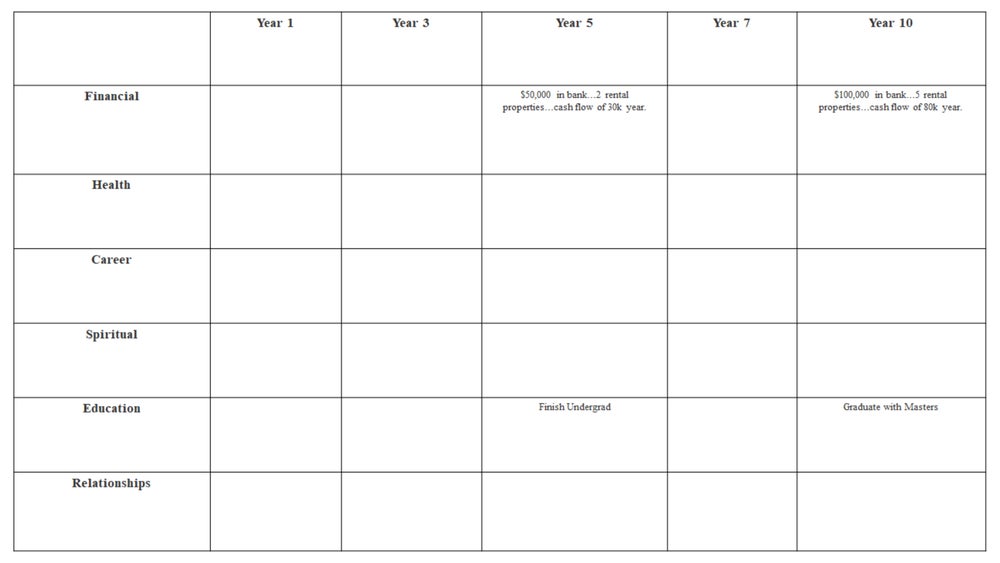June 15, 2020 8 min read
Opinions expressed by Entrepreneur contributors are their own.
Young or old, stable or in transition, starting a new business or trying to find an exit strategy for a mature business, building a 10-year plan can give you a significant edge in living a happier and more fulfilling life. More specifically, for a business owner, it could be the difference between making a profit and harnessing your passion or losing years of your life as success continually remains elusive. The primary objective should be to take control of your future and not to simply be reactive and take what life throws at you.
If you don’t have a written, passionate vision of your future 10 years from now, what are you even doing and why? Have you really thought through your activities right now and what the long-term ramifications will be?
Writing down a plan can be a game changer in your personal growth and happiness. If you feel uncertain about what you want out of life, or unhappy about what you seem to be consistently receiving from this crazy world, make a plan to change it! What will it hurt? What do you have to lose? This could make the difference you have been looking for to get you motivated and focused. Here’s a five-step approach to getting started.
Related: Tax-Savings Strategy: Hiring Your Children and Grandchildren
Step 1: Begin with a picture of the future
The first critical step is to start writing down an ideal scene of what you want your personal future to look like 10 years from now. Don’t worry about grammar or spelling — just write. Let it flow. It’s not going to get published in a journal or the newspaper. It’s personal. Let it be an emotional experience if need be.
I also don’t want you to simply focus on finances or your occupation, but perhaps on relationships, physical health, education and spiritual growth. Picture yourself in the mountains, on a beach or in a place you’re passionate about. Envision what you’ve accomplished over the past 10 years. Who or what type of person are you with, what is in your bank account, what education have finished, what type of business or job do you have? Take the time to meditate, pray and be honest with yourself on what you truly want this future to look like.
Remember, you can always change and modify your plan. It’s yours. But write it down on paper and give it the care and attention it deserves. This is your future. It’s not something to dictate to Siri and bury in “Notes” on your phone or in a journal catching dust on the shelf. You need to be carrying this around with you everywhere you go. Primarily, I want this to accompany your annual Strategic Plan for your education, business, health and personal life.
Finally, be realistic. It’s OK to push yourself with a dream you think you can reach with some effort, but don’t set yourself up for failure. Maybe stating you want to be the President of the United States or a VP of a Fortune 500 Company might be a little much, but who am I to say what you can and can’t do? Maybe something like that is clearly within your reach, but just don’t overdo it; you know what I mean.
Step 2: Work backwards with benchmarks that you need to reach
The goal is to reach your ideal scene in 10 Years, so it actually becomes quite easy to work backwards and determine the practical steps you need to take in order to get there. Some people want to set straight-out goals, but I think it’s easier to work with the end in mind and lay out the stepping stones needed to make one’s dream a reality.
Practically, this means creating five-, three- and one-year objectives that will ultimately get you to your 10-year ideal scene. For example, if you see yourself with 10 rental properties in 10 years, then maybe it would be smart to shoot for five rentals in five years, three in three years and one this year. Getting our head around buying one rental property this year is much easier than a race to get 10 rentals as fast as possible.
Moreover, when we know we have 10 years to get to our scene, we aren’t as rushed or stressed if we were realistic in where we want and could be in the future. This type of mind et also gives us breathing room to make mistakes and adjust our plans along the way.
This is also the state where your plan starts to take shape. Break it down into categories and years, maybe even into a grid (see below). But remember, the categories are yours to establish. It’s your plan!

Of course, the table above is a little small for any serious and detailed plan, but it gets at the concept I’m trying to convey. I would suggest considering a table that consumes an entire page in landscape format. But if not, again, it’s OK. It’s your Plan. There’s no wrong or right way to do it. It’s just important you do it.
[embedded content]
Step 3: Share it
Yes, this is the scary part. I did say your plan wouldn’t be published, but you do have to share it with someone. In fact, I would suggest three-to-five people. The number one reason why: It becomes alive, and you’re now accountable to someone.
A significant benefit is that you want feedback and criticism. Helpful criticism mind you. You’ll need thick skin, but no one should be there to beat you up. If they are rude, mean, negative or demeaning, get them off of your Board. However, don’t be afraid to ask for someone’s opinion and be open and willing to take it.
Step 4: Revisit your plan regularly
Don’t leave your 10-year plan in the drawer. Honestly, I love to carry mine around with me in my bag and take it with me everywhere I go. I like to review it on airplane rides or weekends when I have a free minute and the pressures of the workweek aren’t bearing down on me.
In fact, I suggest you update your plan annually, and at the very least review it every couple of years. Make sure you are making notes to your plan whenever you have a “brilliant idea.” Don’t say to yourself: “I need to do that next quarter when I review my plan.” Write it down now.
Step 5: Manage by statistics
Track your success or failures. Track the numbers and try to quantify your progress when possible. Your numbers and reports, even if you are only keeping track and reporting to yourself, will consistently tell you if you are headed in the right direction. Don’t get discouraged. Make changes as needed. Investing and trying to build wealth takes a little math. Don’t be afraid of it. Embrace it and become accustomed to it.
Finally, don’t be dogmatic or a slave to the plan, and certainly not to the point your miserable or make unwise decisions. For example, to stick with the rental-property decision, if your plan is to have 10 rentals in 10 years, don’t think you have to buy a rental every yearm and certainly not in the first year if you aren’t ready for it. Maybe you have to take one step backwards to take three steps forward. Thus, maybe your first year or two is about getting out of debt, better educated and working under mentors. Then, when the third year comes along, you might be able to purchase two properties a year, and by year five, you are right on track.
Related: The 7-Step Health Care Plan for Small-Business Owners
Remember: It’s not a race. It’s a journey, and most importantly, it’s your journey. Take your time and enjoy the process. Get excited when you make any progress at all. This is your life. Make it what you want and say goodbye to being reactive and feeling like you’re never in control. With a 10-year plan, you are in control and no one else.
loading…
This article is from Entrepreneur.com









